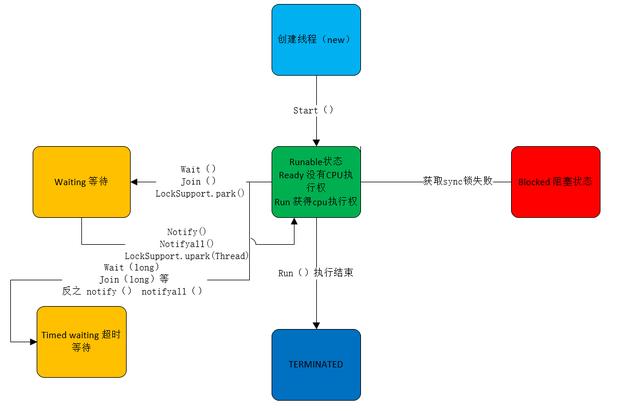JavaеӨҡзәҝзЁӢдёҺй«ҳ并еҸ‘еӯҰд№ пјҲдёҖпјү
еҶҷеңЁејҖеӨҙ пјҢ еёҢжңӣйҖҡиҝҮзі»з»ҹзҡ„еӯҰд№ еҪ»еә•жҺҢжҸЎеӨҡзәҝзЁӢдёҺй«ҳ并еҸ‘ гҖӮ д№ҹеёҢжңӣйҖҡиҝҮеҲҶдә«и·ҹеӨ§е®¶е…ұеҗҢиҝӣжӯҘ пјҢ йғҪиғҪиҝӣе…ҘиҮӘе·ұзҗҶжғідёӯзҡ„е…¬еҸё гҖӮ
javaиҷҡжӢҹжңәз®ЎзҗҶзҡ„еҶ…еӯҳдё»иҰҒеҢ…жӢ¬д»ҘдёӢеҮ дёӘеҢәеҹҹ
з”ұзәҝзЁӢе…ұдә«зҡ„ж•°жҚ®еҢәпјҡ ж–№жі•еҢә е’Ң е Ҷ
зәҝзЁӢйҡ”зҰ»зҡ„еҢәеҹҹпјҡ иҷҡжӢҹжңәж Ҳ жң¬ең°ж–№жі•ж Ҳ зЁӢеәҸи®Ўж•°еҷЁ
зЁӢеәҸи®Ўж•°еҷЁпјҡеҚ з”Ёиҫғе°Ҹзҡ„еҶ…еӯҳ еҸҜд»ҘзңӢдҪңеҪ“еүҚзәҝзЁӢзҡ„жү§иЎҢеӯ—иҠӮз Ғзҡ„дҝЎеҸ·жҢҮзӨәеҷЁ пјҢз”ұдәҺjavaиҷҡжӢҹжңәзҡ„еӨҡдёӘзәҝзЁӢжҳҜйҖҡиҝҮиҪ®жөҒеҲҮжҚўе№¶еҲҶй…ҚеӨ„зҗҶжү§иЎҢж—¶й—ҙзҡ„ж–№ејҸе®һзҺ°зҡ„ гҖӮ еӣ жӯӨжҜҸдёӘзӢ¬з«Ӣзҡ„зәҝзЁӢйғҪжңүдёҖдёӘзӢ¬з«Ӣзҡ„зәҝзЁӢз§ҒжңүзЁӢеәҸи®Ўж•°еҷЁ гҖӮ
иҷҡжӢҹжңәж ҲпјҡиҷҡжӢҹжңәж Ҳд№ҹжҳҜзәҝзЁӢз§Ғжңүзҡ„ гҖӮ е®ғзҡ„з”ҹе‘Ҫе‘ЁжңҹдёҺзәҝзЁӢзӣёеҗҢ пјҢ жҜҸдёӘзәҝзЁӢжү§иЎҢж—¶йғҪдјҡеҲӣе»әдёҖдёӘж Ҳеё§ пјҢ з”ЁдәҺеӯҳеӮЁзәҝзЁӢзҡ„еұҖйғЁеҸҳйҮҸиЎЁ пјҢ ж“ҚдҪңж•°ж Ҳ пјҢ еҠЁжҖҒй“ҫжҺҘ пјҢ ж–№жі•еҮәеҸЈзӯү пјҢ дёҖдёӘзәҝзЁӢзҡ„з”ҹе‘Ҫе‘Ёжңҹе°ұеҜ№еә”зқҖдёҖдёӘж Ҳеё§зҡ„е…Ҙж ҲеҮәж Ҳзҡ„иҝҮзЁӢ гҖӮ
жң¬ең°ж–№жі•ж Ҳпјҡ и°ғз”Ёnative ж–№жі•жңҚеҠЎзҡ„ гҖӮ и°ғз”Ёе…¶д»–иҜӯиЁҖзҡ„жң¬ең°зұ»еә“ гҖӮ
java е ҶпјҡjavaиҷҡжӢҹжңәз®ЎзҗҶзҡ„еҶ…еӯҳдёӯжңҖеӨ§зҡ„дёҖеқ— пјҢ javaе ҶжҳҜжүҖжңүзәҝзЁӢе…ұдә«зҡ„ гҖӮ еңЁиҷҡжӢҹжңәеҗҜеҠЁзҡ„ж—¶еҖҷеҲӣе»ә пјҢ еңЁеҶ…еӯҳеҢәеҹҹзҡ„е”ҜдёҖзӣ®зҡ„е°ұжҳҜеӯҳж”ҫеҜ№иұЎе®һдҫӢ гҖӮ javaе ҶжҳҜеһғеңҫ收йӣҶеҷЁз®ЎзҗҶзҡ„дё»иҰҒеҢәеҹҹ пјҢ еҫҲеӨҡж—¶еҖҷд№ҹеҸ«еҒҡGCе Ҷ пјҢд»ҺеҶ…еӯҳеӣһ收角еәҰжқҘзңӢ пјҢ з”ұдәҺзҺ°еңЁж”¶йӣҶеҷЁеҹәжң¬йғҪйҮҮз”ЁеҲҶ代收йӣҶз®—жі• пјҢ жүҖд»Ҙjavaе ҶиҝҳеҸҜд»Ҙз»ҶеҲҶдёәж–°з”ҹд»Је’ҢиҖҒе№ҙд»Ј гҖӮ
ж–№жі•еҢәпјҡеҗ„дёӘзәҝзЁӢеҶ…еӯҳе…ұдә« пјҢ е®ғз”ЁдәҺеӯҳеӮЁе·Іиў«иҷҡжӢҹжңәеҠ иҪҪзҡ„зұ»дҝЎжҒҜ пјҢ еёёйҮҸ пјҢ йқҷжҖҒеёёйҮҸпјӣ иҝҗиЎҢж—¶еёёйҮҸжұ жҳҜж–№жі•еҢәзҡ„дёҖйғЁеҲҶ пјҢ classж–Ү件дёӯйҷӨдәҶжңүзұ»зҡ„зүҲжң¬ пјҢ еӯ—ж®ө пјҢ ж–№жі• пјҢ жҺҘеҸЈ пјҢ иҝҳжңүдёҖйЎ№дҝЎжҒҜжҳҜеёёйҮҸжұ
еӨҡзәҝзЁӢзҡ„6з§ҚзҠ¶жҖҒпјҡеңЁThread.classдёӯе®ҡд№үдәҶзәҝзЁӢзҡ„еҗ„з§ҚзҠ¶жҖҒ
public enum State {// ж–°е»әNEW,//еҸҜиҝҗиЎҢиҝҗиЎҢ ready еҸҜиҝҗиЎҢ дҪҶжҳҜжІЎжңүcpuжү§иЎҢжқғRUNNABLE,// йҳ»еЎһ иҺ·еҸ–й”ҒеӨұиҙҘ synchronizedж–№жі• еқ—BLOCKED,// ж— йҷҗзӯүеҫ… йңҖиҰҒиў«е”ӨйҶ’ wait join LockSupport.park()WAITING,// жңүйҷҗзӯүеҫ… и¶…ж—¶д№ӢеҗҺ еҸҜд»ҘиҮӘеҠ©иҝӣе…ҘrunnableзҠ¶жҖҒTIMED_WAITING,// з»“жқҹ runжү§иЎҢе®ҢжҲҗTERMINATED;} ж–Үз« жҸ’еӣҫ
ж–Үз« жҸ’еӣҫ
зәҝзЁӢжөҒиҪ¬зҠ¶жҖҒеҸҳеҢ–
start() ж–№жі•
зәҝзЁӢдёҚиғҪиў«startдәҢж¬Ў еҪ“зәҝзЁӢ第дёҖж¬Ўиў«newзҡ„ж—¶еҖҷ threadStatus зҠ¶жҖҒжҳҜ0 зӣёеҪ“дәҺNEWзҠ¶жҖҒ еҶҚж¬Ўиў«еҗҜеҠЁдјҡжҠӣеҮә new IllegalThreadStateExceptionејӮеёё
public synchronized void start() {/*** This method is not invoked for the main method thread or "system"* group threads created/set up by the VM. Any new functionality added* to this method in the future may have to also be added to the VM.** A zero status value corresponds to state "NEW".*///еҲӨж–ӯзәҝзЁӢзҠ¶жҖҒ еҰӮжһңдёҚдёә0 жҠӣеҮәејӮеёёif (threadStatus != 0)throw new IllegalThreadStateException();/* Notify the group that this thread is about to be started* so that it can be added to the group's list of threads* and the group's unstarted count can be decremented. */group.add(this);boolean started = false;try {start0();started = true;} finally {try {if (!started) {group.threadStartFailed(this);}} catch (Throwable ignore) {/* do nothing. If start0 threw a Throwable thenit will be passed up the call stack */}}} start() е’Ң run()ж–№жі•еҢәеҲ«
Runable run()еҸӘжҳҜзәҝзЁӢеҜ№дёҡеҠЎйҖ»иҫ‘зҡ„дёҖдёӘжҠҪиұЎжҺҘеҸЈ startпјҲпјүйҮҢйқў start0пјҲпјүдјҡи°ғз”Ё C++зҡ„жң¬ең°зұ»еә“ и°ғз”Ёrunж–№жі•
Thread жһ„йҖ ж–№жі•
public Thread() {init(null, null, "Thread-" + nextThreadNum(), 0);}private void init(ThreadGroup g, Runnable target, String name,long stackSize) {init(g, target, name, stackSize, null);}public Thread(ThreadGroup group, Runnable target, String name,long stackSize) {init(group, target, name, stackSize);}
жҺЁиҚҗйҳ…иҜ»
- и®Ўз®—жңәдё“дёҡеӨ§дёҖдёӢеӯҰжңҹпјҢиҜҘйҖүжӢ©еӯҰд№ JavaиҝҳжҳҜPython
- жңӘжқҘжғіиҝӣе…ҘAIйўҶеҹҹпјҢиҜҘеӯҰд№ PythonиҝҳжҳҜJavaеӨ§ж•°жҚ®ејҖеҸ‘
- еӯҰд№ еӨ§ж•°жҚ®жҳҜеҗҰйңҖиҰҒеӯҰд№ JavaEE
- д»ҺдәӢJavaејҖеҸ‘ж—¶еҸ‘зҺ°еҹәзЎҖе·®пјҢжҳҜеҗҰеә”иҜҘйҖүжӢ©иҫһиҒҢиҮӘеӯҰдёҖж®өж—¶й—ҙ
- 2021е№ҙJavaе’ҢPythonзҡ„еә”з”Ёи¶ӢеҠҝдјҡжңүд»Җд№ҲеҸҳеҢ–пјҹ
- Intel 12д»ЈCPUжӣқе…үпјҡдёҚеҸӘ16ж ё24зәҝзЁӢ
- AMD Zen3зәҝзЁӢж’•иЈӮиҖ…жӣқж–ҷпјҡ16ж ёеҝғеӣһеҪ’гҖҒеҗҚеӯ—еҮҢд№ұ
- жҷ®йҖҡеӨ§еӯҰи®Ўз®—жңәдё“дёҡзҡ„жң¬з§‘з”ҹпјҢиҜҘйҖүжӢ©дё»ж”»еүҚз«ҜиҝҳжҳҜJava
- иӢұзү№е°”Alder Lake-Sж—©жңҹе·ҘзЁӢж ·е“Ғжӣқе…үпјҡ16ж ё/24зәҝзЁӢ дё»йў‘д»…1.4GHz
- JavaиҜӯиЁҖдјҡдёҚдјҡйҡҸзқҖе®№еҷЁзҡ„е…ҙиө·иҖҢиЎ°иҗҪ














